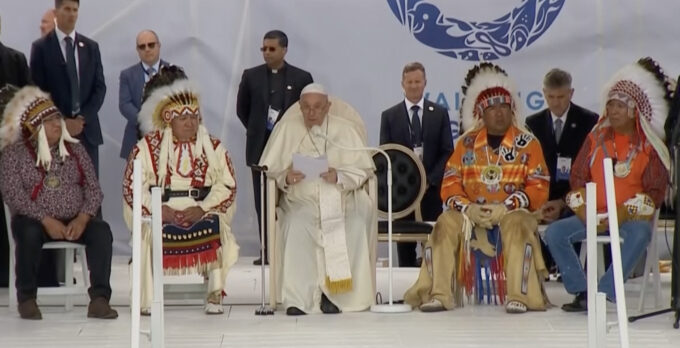
EDMONTON NOTEBOOK
Dear Blog Readers,
I am writing from Edmonton, Canada where I came to cover the Pope’s apology to the Indigenous people for the devastating acts of the Church against children in residential schools.
From the 1850s to 1970s over 150,000 Indigenous children of the First Nations, Métis, Inuit and other groups were taken from their families, placed in Church-run boarding schools where they were not allowed to speak their language or see their families in an effort to eradicate their beliefs and traditions, replacing them with Christian beliefs, and assimilating them into mainstream Canadian culture.
Physical abuse was rampant in the schools with regular corporal punishment and sexual molestation. Three-quarters of these schools were run by the Catholic Church.
The residential school experience has caused untold suffering in the Indigenous communities in Canada with leaders saying it is one of the causes of drug and alcohol abuse. Even just skimming through the reports, cases of whippings and beatings, nighttime molestations and even, reports of an electric chair used on students emerge.
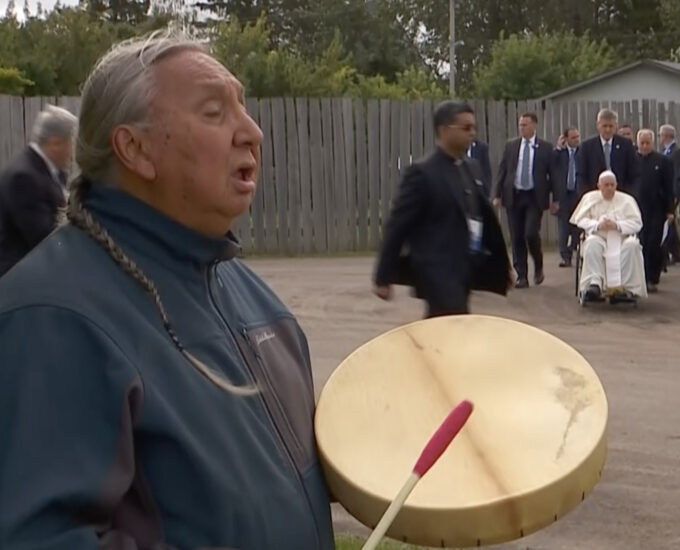
Calling his trip a “penitential journey”, the Pope delayed the protocol visit to Canada’s government officials, the usual first stop on any foreign trip, and instead flew straight to Edmonton and then traveled to Maskwacis, a Cree word meaning “Bear Hills” to meet with First Nations, Métis and Inuit peoples and deliver his apology.
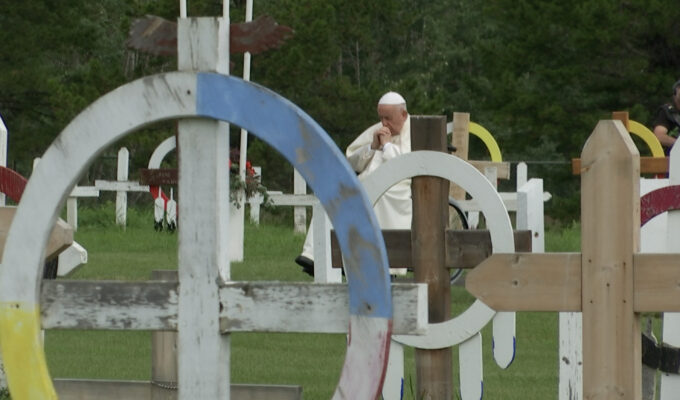
Maskwacis is on the site of the former Ermineskin Residential School, which has now been destroyed. Some 2,000 survivors, chiefs, elders, and knowledge keepers gathered in a circular pow wow space to wait for the Pope. When he arrived, the Pope, now being pushed in a wheelchair due to problems with his knee, was first taken to the cemetery on the grounds of the former school where he sat in silent prayer.
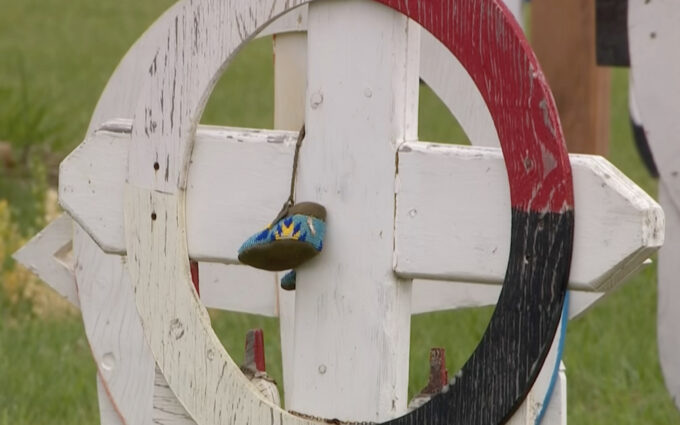
Before the Pope spoke, a group of people wove through the crowd carrying a long red banner, on it written the names of 4,000 Indigenous students who died at the schools or simply never returned home. Then the chiefs processed in, wearing their traditional headdress (they call them Warrior Bonnets) and sat with the Pope on the stage.
It wasn’t long before the Pope delivered the words everyone was waiting for. He said:
“I am here because the first step of my penitential pilgrimage among you is that of again asking forgiveness, of telling you once more that I am deeply sorry. Sorry for the ways in which, regrettably, many Christians supported the colonizing mentality of the powers that oppressed the indigenous peoples. I am sorry. I ask forgiveness, in particular, for the ways in which many members of the Church and of religious communities cooperated, not least through their indifference, in projects of cultural destruction and forced assimilation promoted by the governments of that time, which culminated in the system of residential schools.”
The Pope spoke in Spanish, and the crowd of survivors looked on silently, many wiping tears from their eyes. At the end of each paragraph, he stopped and a translator repeated what he said in English. On hearing the words “I am sorry, I am sorry,” in English an applause spread through the crowd.
Chief Tony Alexis of the Alexis Nakota Sioux Nation, later told reporters, “As soon as the apology started, people were triggered immediately, you could see it in the audience.” He added, “It triggered an opening of a wound, again.”
The Pope continued:
“… this was a disastrous error, incompatible with the Gospel of Jesus Christ. It is painful to think of how the firm soil of values, language and culture that made up the authentic identity of your peoples was eroded, and that you have continued to pay the price of this. In the face of this deplorable evil, the Church kneels before God and implores his forgiveness for the sins of her children I myself wish to reaffirm this, with shame and unambiguously. I humbly beg forgiveness for the evil committed by so many Christians against the indigenous peoples.”
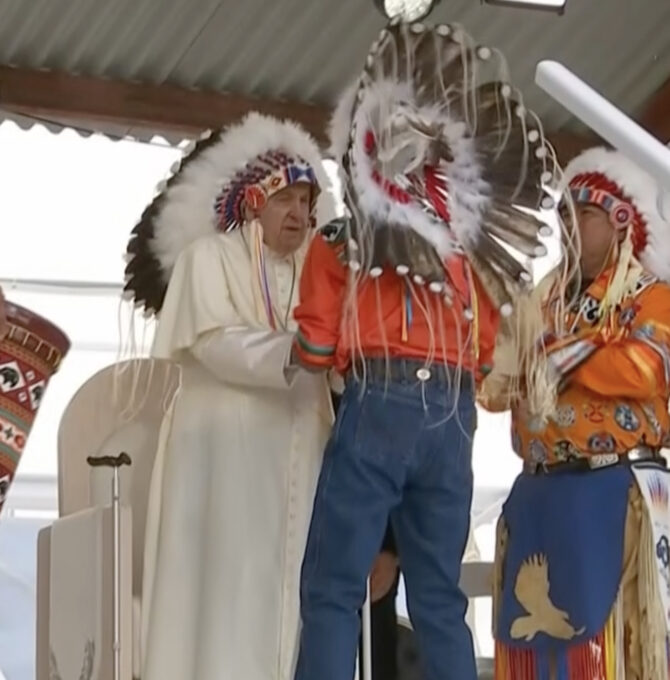
At the end of the ceremony, with traditional drums beating a solemn rhythm, Chief Wilton Littlechild made his way up to the stage and placed a headdress on Pope Francis. The Pope stood silently with the headdress on for a few moments before it was removed by one of his aides.
This symbolic gesture has been making waves for the past few days.
Following the ceremony some Indigenous leaders held a press conference.
When asked why the headdress was put on the Pope, Jon Crier, a residential school survivor and First Nations elder, said, “A headdress is honoring a man as an honorary chief and leader in a community. And so in doing that we have adopted him as one of our leaders in the community. And so it is an honoring of the man, it is an honoring of the work that he has done, and it is also recognizing from the community that here is a man that belongs into our tribe.”
But not all the Indigenous felt that the Pope “belongs in their tribe.” Hours after the event, anger over the gesture spilled forth on Facebook and Twitter with Indigenous arguing that the gesture was premature and inappropriate.
As the ceremony came to a close and the crowd began to leave, one Indigenous woman in traditional dress stepped out in front of the stage, raised her right arm in a fist and began to sing while tears ran down her face.
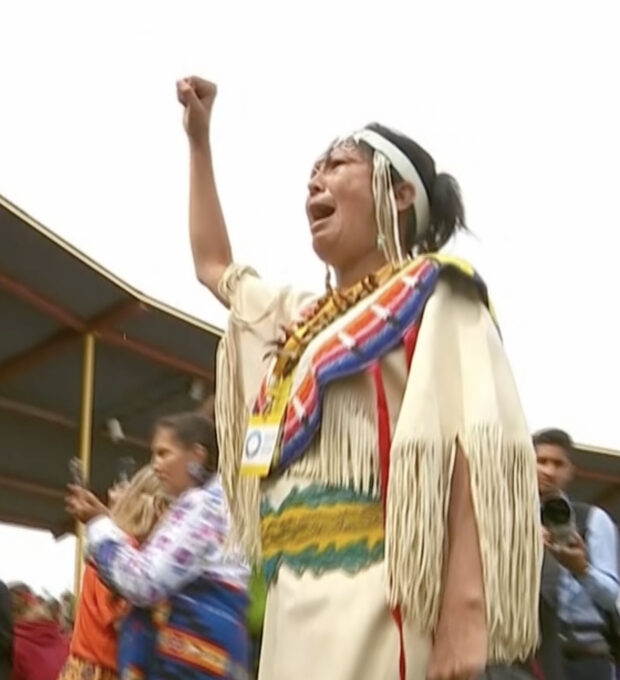
The chiefs and the Pope looked down at her appreciatively, but a tad perplexed. Some people thoughts she was singing the Canadian national anthem in the Cree language.
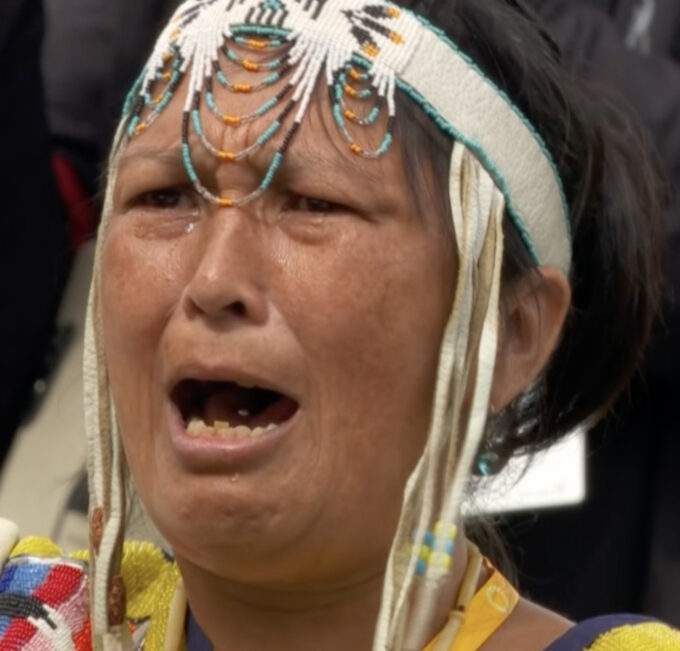
The woman was Si Pih Ko, an Indigenous Cree and she was singing Ka ka na Tak, or “Our Village” in Cree, which she described as the “language of the four winds.” She later told Canadian journalists that her brother went through the residential school system.
“I was speaking the law of the land directly to him and the ones that were standing behind him,” Si Pih Ko told Canadian Television News. “I noticed the corporate chiefs are behind him, and not behind me, that’s what made me cry the most, because they were standing there strong with him.”
When she finished her song, she turned and walked away. Later, she said on Canadian television that she shook the fringes on her traditional dress to free all those survivors standing behind her from their pain.
The pain was evident in many. I was struck by the comment of Evelyn Korkmaz, a residential school survivor, after she heard the Pope’s apology.
“It has been a very emotional day for me as a survivor,” she said, “I’ve waited 50 years for this apology and finally today I heard it. Unfortunately, many family and community members who went to residential schools were not able to hear it because they had passed on through suicide, alcohol addiction, and substance-abuse because they could not endure or live with the trauma that they endured in these residential schools.”
The population of Canada is 38 million, of which 1.67 million are Aboriginal, according to the Canadian government. The government set up a Truth and Reconciliation Commission in 2008 to investigate the abuses and attempts at “cultural assimilation” at the residential schools which were funded by the Canadian government. The Commission found that the schools were “part of a coherent policy to eliminate Aboriginal people as distinct peoples and to assimilate them into the Canadian mainstream against their will.”
Unlike other trips, I was not traveling on the Papal plane, so I was not moving around in the entourage of journalists close to the Pope. Instead, I flew to Edmonton on my own and was working with two AP video-journalists from New York, Ted Shaffrey and David R. Martin. They went to all the events, filming and doing interviews and I stayed in the press center, edited the video and wrote stories. I watched every moment of the trip from the press center so I felt I was very close and yet so far away from everything that was going on.
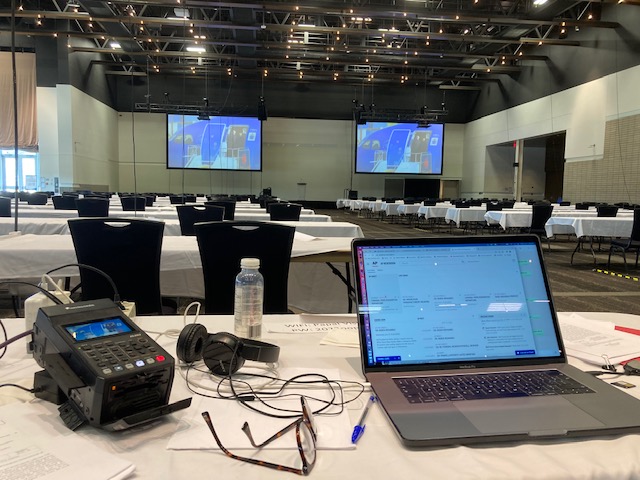
Four thousand Indigenous children died or never returned from residential schools stretching across Canada from British Columbia to Quebec, and many were left in unmarked graves. In May 2021, the remains of 215 children were found in unmarked graves on the grounds outside the Kamloops School in British Columbia.
The children died of many causes including influenza, mumps, measles, chicken pox and tuberculosis. Some got small graves with wooden crosses, others were buried in mass graves in fields near the schools with nothing to mark their brief lives.
AP video-journalist Ted Shaffrey did an interview with Dr. Kisha Supernant, the Director of the Institute of Prairie and Indigenous Archeology at the University of Alberta a day ahead of the Pope’s arrival. Dr. Supernant has been working with radar-penetrating technology to find unmarked graves of these children. She became emotional as she spoke about the Pope’s visit and the work she does.
“As a mother, as an indigenous woman, I really think a lot about what would have happened to my child had I been born 100 years ago. The thought of these children dying far away from home, often sick, perhaps they were buried in a grave that had a little wooden cross, but their parents sometimes didn’t even know that they had died, and the only way they found out was if their child didn’t come home in the summer or didn’t come home after years away and they had no idea where their resting place was and what happened to them.”
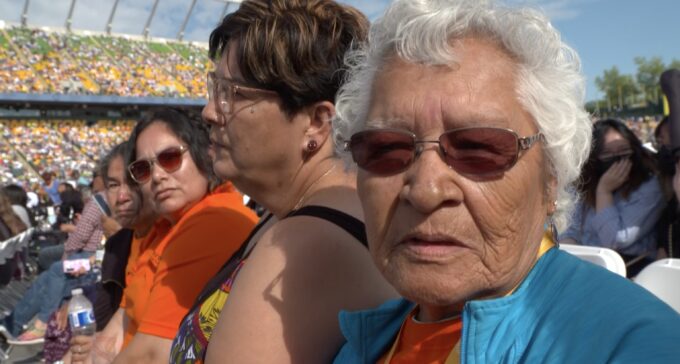
At a Mass in Edmonton, one day after the apology, my video-journalist colleague, David R. Martin, met Albertine Whitefish Ahtehkamake, a grandmother and mother of 13 children, who had been through the residential schools. “I feel different,” she said as she waited for the Pope to arrive at the Commonwealth Stadium in Edmonton. “It is like I am healed at this moment because I have been to a residential school for eight years and I know what is what. I don’t know. I know there is some people who are not really satisfied about this thing. I know they can’t forgive other people. They can’t accept this one at this time, but I do. I do forgive.”
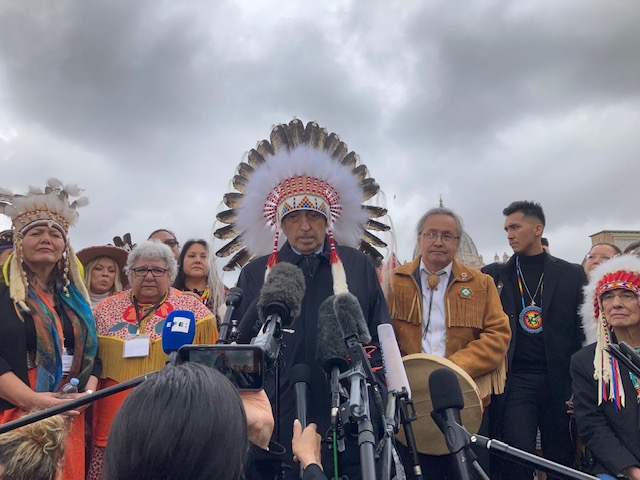
For Phil Fontaine, former Chief of the Assembly of First Nations, the Pope’s visit was “the achievement of the impossible dream.” I interviewed Phil Fontaine, a survivor of the residential schools, on his visit to the Vatican in March, part of his decades long effort to get the Vatican to acknowledge and to apologize for the role of the Church in the residential schools.
AP divided up the television coverage of this trip with Reuters, so once the Pope left Edmonton, and flew to Quebec, the Reuters team took over. This arrangement gave me an afternoon to explore Edmonton.
Sadly, I was struck at the great numbers of homeless people in the city. Apparently my hotel was near a homeless shelter in the city center, but it seemed as though the homeless were the only people around. On top of that, many of them seemed to be completely drugged out, lying bent over or in odd positions on the sidewalks. I asked a number of people about it – in my hotel, in a café, at a drugstore, and in a taxi – they all said that Edmonton has a huge homeless problem made much worse by Covid. On top of that there is an opioid crisis, with many of the homeless getting drugs laced with fentanyl. Many people told me that most of the homeless are Indigenous. Is this a result in part of loss of identity caused by the residential school system? Certainly the comments of Evelyn Korkmaz, the residential school survivor, would imply that this is the case. I wish I could have stayed another week in Edmonton for AP to do more reporting on this question. But budgets are tight and my assignment if over, so I am heading home.
A big thanks to Associated Press’s super-star video-journalists from New York, Ted Shaffrey and David R. Martin, for all their work covering this visit. (We even managed to sneak in watermelon margaritas one evening in Edmonton)
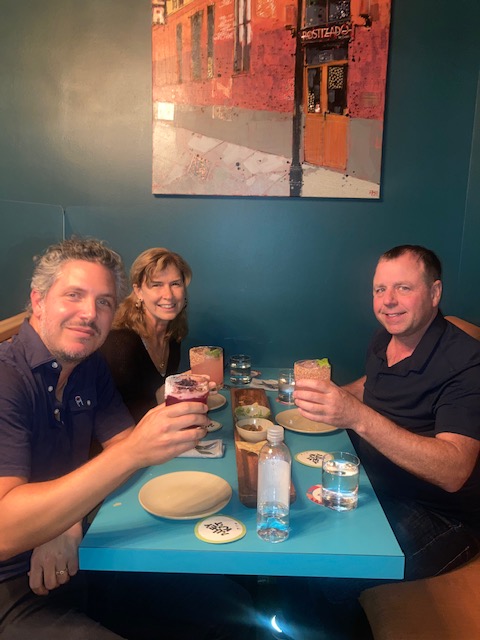
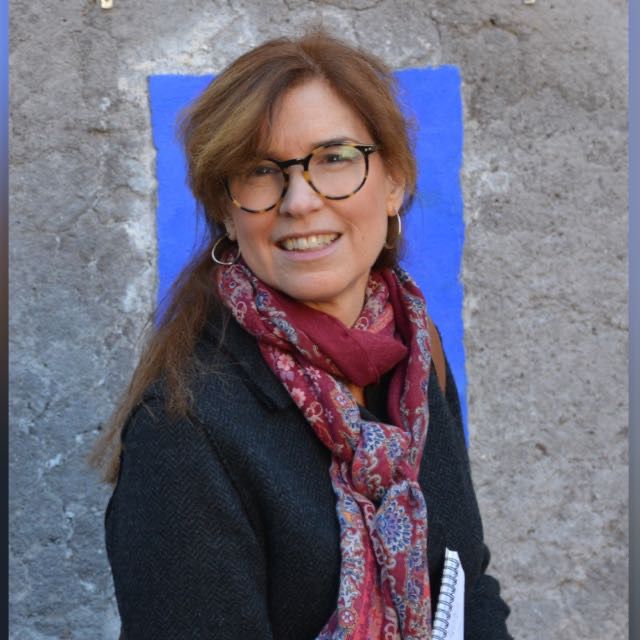
Thank you Trisha for this indepth report. What a terribly sad story this is. I think more is needed than a simple “sorry”. The Catholic Church should put its “money where its mouth is”. How about building homeless shelters and drug rehab centers, that would truly be a small step in the right direction.
I agree with you, Lega. I did not delve into the question of compensation but both the Canadian government and the Catholic Church (through the Catholic Bishops Conference of Canada) are paying compensation. It is worth a whole separate article. And, more than just money, as you say, concrete help like homeless shelters and drug rehab centers are a good idea.
I appreciate the insights you share. The mainstream coverage I saw was not so personal, not so insightful. Thank you.
Thank you so much, Laurel. I have hardly been blogging anymore and am so happy to see that some people still read what I write and find it interesting.
Such a well-written piece, and a fair recounting.
Trisha, thank you for this!
Thank you, Robert. I am so pleased to see you read my blog.
Thank you Trisha for this deeply moving, insightful telling of the Pope visit and how it touched so many people’s lives. I think more people in Europe should remember what happened and I also look forward to reading your article on compensation.
Thank you, Amrita!